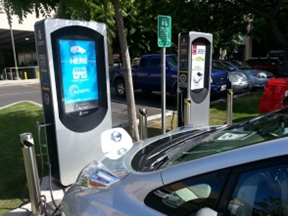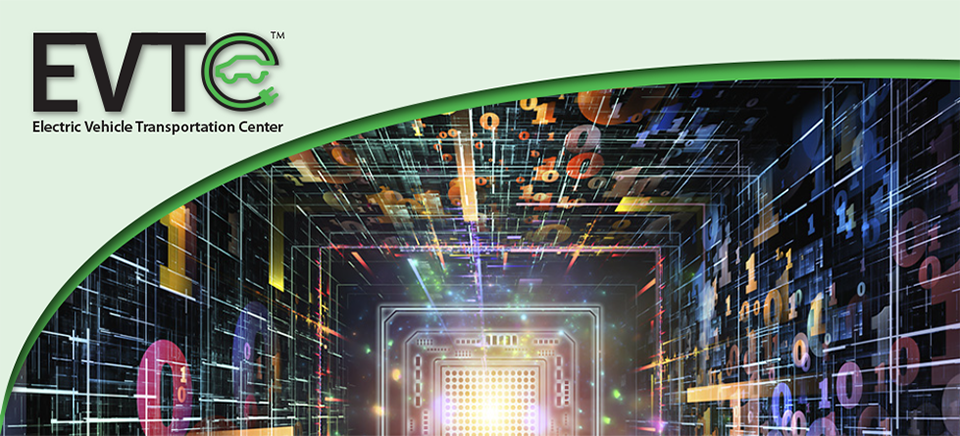Project 17:
Electric Vehicle Energy Impacts
Objective
Evaluate the impacts of electric vehicles (EVs) and associated renewable power generation on reduction of petroleum imports to Hawaii. The analysis will concentrate on the Island of Oahu and will include the effects of number of vehicles, charging strategies, renewable energy penetration levels and greenhouse gas reductions.
Brief Description
This project focused on the interaction of passenger EVs into an isolated utility grid characterized by exceptionally high levels of wind and solar energy. The project also investigated the impacts of EVs on net petroleum imports to Hawaii, the nation's most petroleum dependent state. The analysis included consideration of charging strategies and renewable energy penetration levels on the electricity grid and quantified EV mileage and emissions under controlled charging profiles. EVs were found to reduce energy consumption and emissions compared with similar gasoline vehicles.
Research Results
In the first phase, analysis was conducted on grid-connected EVs to quantify net petroleum use by EVs on Oahu, under controlled charging profiles, with and without high penetrations of renewable resources. EVs were found to reduce energy consumption and emissions compared with similar gasoline vehicles, based on modeled scenarios. As modifications are made to the power grid with increasing amounts of wind and solar energy, the comparable EV fuel use in Miles per Gallon Equivalent to gasoline (MPGe) improves. For example, EVs would achieve 44 MPGe with 36% renewable electricity generation and 20% of the vehicles on Oahu replaced with EVs. As for other regions across the U.S. with increasingly cleaner sources of power generation, the interrelationship between EV charging and power plant fuel use is essential when considering the true fuel requirements and emissions of EVs. Unlike most of the U.S., Hawaii's primary source of fuel for electricity is petroleum. For Hawaii, these changes to both ground transportation and electricity generation could have a significant impact on reducing net petroleum imports, emissions and enhancing energy security and economic stability. These results are presented in the report the State of Electric Vehicles In Hawaii referenced below.
 |
| Hawaii charging stations. (Photo: Katherine McKenzie) |
EVs also become increasingly important in helping to balance intermittent power generation with load as Hawaii moves toward renewable power standards (RPS) of 30% by 2020, 40% by 2030, 70% by 2040 to 100% by 2045. With future EV adoption levels, the significant amount of battery energy storage could potentially contribute to balancing the power grid as more intermittent renewables are added and less power is generated from fossil fuels. Utilities in Hawaii face unprecedented technical and economic challenges to meet these goals. Along with balancing intermittent renewables, EVs can be used to support grid stability and power quality. Modeling and analysis has become critical to quantify the potential synergies of integrating EVs into power grids characterized by high penetration of intermittent renewable energy. Small changes such as the level of EV adoption, operational changes by the utility, or renewable energy levels reveal significant impacts on future outcomes. As a result, assessing the value of grid-connected vehicle interactions becomes meaningful in achieving Hawaii's 100% renewable energy goal.
Future scenarios modeled by HNEI and GE for high amounts of wind and solar energy on both Oahu and Maui show that changes to the utilities' operating practices were made such that the curtailed wind and solar energy is reduced to about 3%. Other modeling with future scenarios of 50% wind and solar energy led to significant curtailments of 12% to 27% depending on the mix of resources. In high solar scenarios (over 40%), approximately 90% of any additional solar energy would be curtailed. Additionally, scenarios were assessed on the impact of linking Oahu and Maui's power systems with a sub-sea, inter island cable. This work was presented in the report Hawaii Renewable Portfolio Standards Study 2015.
The next phase of the EV analysis (under other funding) will build on grid modeling with increased wind and solar energy up to 70% renewable penetration levels, augmenting the significance of EVs in balancing these intermittent power sources. Additionally, EV energy charging and storage will be analyzed as a means of improving power quality and stability while increasing renewables.
Impacts/Benefits
 |
| EVs at Hawaii charging station. Photo: Katherine McKenzie |
Benefits of modeling and analysis efforts are expected in the form of increased understanding of EVs to balance renewable energy integration on the power grid, with direct application to isolated grids, microgrids and more universal application on larger grids at the distribution or circuit level.
Further GE modeling is planned to simulate the ever increasing levels of renewables on the grid, especially distributed PV. This analysis will in turn be used to inform The State of Electric Vehicles in Hawaii which will be updated to summarize the dynamic and rapidly changing situation with EV integration in Hawaii. EV integration in Hawaii can provide a window on the future for many regions of the continental US.
Reports
McKenzie, K., (2015). The State of Electric Vehicles In Hawaii (HNEI Rep. No. HNEI-05-15). Honolulu, HI: University of Hawaii.
McKenzie, K., (July, 2016). The State of Electric Vehicles in Hawaii: 2016 Update (HNEI Rep. No. HNEI-09-16). Honolulu, HI: University of Hawaii.
McKenzie, K., (January, 2016). Electric Vehicle Transportation and Power Grid Integration, Hawaii Natural Energy Institute, University of Hawaii at Manoa, presented at Women in Renewable Energy, Honolulu, Hawaii.
McKenzie, K., (February, 2016). Electric Vehicle Transportation and Power Grid Integration, Hawaii Natural Energy Institute, University of Hawaii at Manoa, presented at Engineers and Architects of Hawaii, Honolulu, Hawaii.
McKenzie, K., (June, 2016). Interaction of EVs In a High Renewables Island Grid. Hawaii Natural Energy Institute, University of Hawaii at Manoa, presented at iTEC IEEE, Dearborn Michigan.
McKenzie, K., (May, 2017). Electrical Vehicle Energy Impacts, Hawaii Natural Energy Institute, University of Hawaii at Manoa.
Project Title: University: Principal Investigator: PI Contact Information: Funding Source: Total Project Cost: Agency ID or Contract Number: Start date: End date: |
